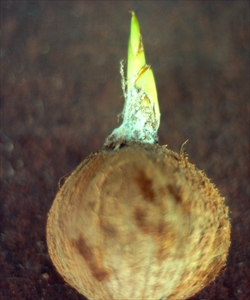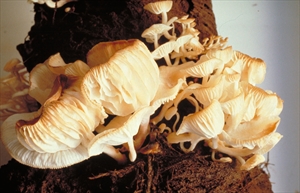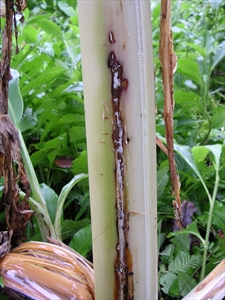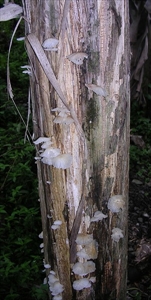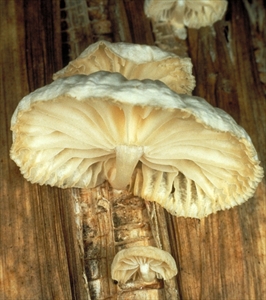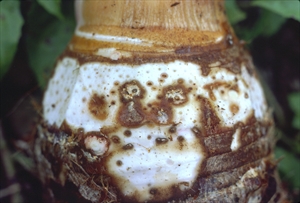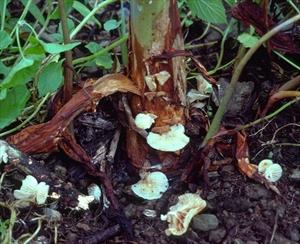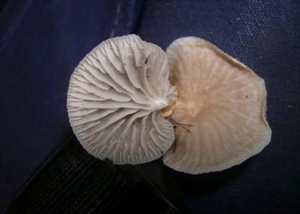Coconut embryo rot, coconut pre-emergence shoot rot, banana sheath rot, taro corm rot, sheath rot of maize.
Pacific Pests, Pathogens, Weeds & Pesticides - Online edition
Pacific Pests, Pathogens, Weeds & Pesticides
Coconut embryo rot (070)
Marasmiellus inoderma (previously known as Marasmiellus semiustus).
South America, North Africa, Oceania. Marasmiellus inoderma is recorded from Federated States of Micronesia (coconut), Palau (banana), Papua New Guinea (coconut), Samoa (coconut) and Solomon Islands (banana, coconuts, taro). In American Samoa, Marasmiellus semiustus is recorded from taro, and in Fiji from banana. In French Polynesia, Marasmiellus stenophyllus is recorded from taro. The fungus is also present in Australia, Cook Islands, Palau, Tuvalu, and Vanuatu.
Coconut, banana, taro and weeds, causing minor diseases. It is also reported as a sheath rot disease of maize, and a crown rot of rice, but not in the Pacific.
On coconut: Infection by Marasmiellus inoderma occurs while the seednuts are attached to the coconut palm. Most likely, it occurs as airborne spores, which enter through the stalk (or calyx) end of the seednut, colonise the fibrous husks and grow beneath the brown cap as it is raised for germination (Photo 1). The embryo is destroyed, and the fungus enters the nut cavity forming a pinkish-white fungal growth floating on the liquid endosperm - the milk. Foul-smelling secondary rots often develop.
Where shoots survive early infection, brown rots occur at the base of the leaves and stems often associated with large amounts of white fungal growth (Photo 2). Usually, seedlings overcome the attack, but growth may be slow. Sometimes, the plants may be killed if growing conditions are poor. Toadstools form on the nut and at the base of the seedlings (Photo 3).
Possibly, other seednuts become infected in the nursery, either by airborne spores or from the fungus in the soil.
On banana: Outer leaf sheaths and leaf bases wither and decay, leaves are slow to emerge and are stunted (Photo 4). White or pink fungal growth commonly occurs in large irregular patches between the leaf sheaths (Photo 5). In wet weather, toadstools develop on the lower parts of the stem (Photos 6&7), and on decaying leaves and other debris on the soil. The roots may also be attacked.
On taro: The fungus rots the outer leaves and causes a shallow corm rot (Photo 8), although on over-mature plants the entire corm may be decayed and filled with white mycelium. Toadstools are often seen on the decaying petioles (Photo 9). The disease is reported from the weather coast of Guadalcanal, Solomon Islands.
On all hosts, toadstools are produced in wet weather, commonly on dead seednuts in the coconut nursery, and on the outer leaves of banana and taro (Photo 10). Masses of spores are released from these toadstools and spread by wind. Apart from spores, the fungus is spread large distances in planting material - in seednuts, and in the old outer leaves of banana and corms of taro.
In Solomon Islands, 15% of Malayan Red Dwarf seednuts germinate on the palm, and 1-2 of these are infected or killed by Marasmiellus inoderma. Overall, losses are not high, and vary between varieties. By contrast, in Samoa, losses of 50% are reported in the nursery of the seedgarden at Olomanu producing Malayan Dwarf x Rennell seednuts.
On banana and taro Marasmiellus inoderma causes a minor disease.
Look for seednuts that do not germinate, remove the husk and look for white fungal growth above the germination pore or thick fungal mats inside the cavity. Look for early death of leaves of banana and taro, and white fungal growth binding the leaves together. Look for white or light brown toadstools on seednuts, and stems of banana and taro.
BIOSECURITY
Marasmiellus inoderma is not the only marasmioid found in seednuts: Marasmiellus cocophillus (see Fact Sheet no. 69) and Marasmiellus albofuscus (see Fact Sheet no. 484), Marasmius crinisequi (see Fact Sheet no. 05), as well as another basidiomycete fungus, Rigidoporus zonalis, associated with white pocket rot disease of trees. Because of this the FAO/IBPGR Technical Guidelines for the Safe Movement of Coconut Germplasm should be followed when movements of coconuts are made between countries:(http://www.bioversityinternational.org/e-library/publications/detail/coconut/).
CULTURAL CONTROL
- On coconut, remove ungerminated seednuts from the nursery before toadstools form.
- On banana:
- select planting material carefully, choosing plants free from the fungus, and remove all old decaying outer leaves.
- use mulches and manures to promote vigorous growth.
- remove diseased plants as they occur.
- On taro (as with banana), select planting material carefully, choosing plants free from the fungus, and remove all old decaying outer leaves.
RESISTANT VARIETIES
Local tall varieties are much more resistant to the disease compared to hybrids with variety Malayan Dwarf as the female parent.
CHEMICAL CONTROL
Post-harvest dips of coconuts in a range of fungicides have been tried in both Solomon Islands and Samoa, but none have improved seednut germination consistently.
____________________
When using a pesticide, always wear protective clothing and follow the instructions on the product label, such as dosage, timing of application, and pre-harvest interval. Recommendations will vary with the crop and system of cultivation. Expert advice on the most appropriate pesticides to use should always be sought from local agricultural authorities.
AUTHORS Helen Tsatsia & Grahame Jackson
Information from Gerlach WWP (1988) Plant diseases of Western Samoa. Samoan German Crop Protection Project, Deutsche Gesellschaft für Technische Zusammenarbeit (GTZ) Gmbh, Germany; and from Kohler F et al. (1997) Diseases of cultivated crops in Pacific Island countries. South Pacific Commission. Pirie Printers Pty Limited, Canberra, Australia; and from (including Photo 10) McKenzie E (2013) Marasmiellus inoderma: PaDIL - (http://www.padil.gov.au).
Produced with support from the Australian Centre for International Agricultural Research under project PC/2010/090: Strengthening integrated crop management research in the Pacific Islands in support of sustainable intensification of high-value crop production, implemented by the University of Queensland and the Secretariat of the Pacific Community.
